ZTE BLADEA520 LTE/WCDMA/GSM (GPRS) Multi-Mode Digital Mobile Phone User Manual
ZTE Corporation LTE/WCDMA/GSM (GPRS) Multi-Mode Digital Mobile Phone Users Manual
ZTE >
Users Manual
ZTE BLADE 520
User Manual

2
LEGAL INFORMATION
Thank you for choosing this ZTE mobile device. In order to
keep your device in its best condition, please read this
manual and keep it for future reference.
Copyright
Copyright © 2016 ZTE CORPORATION
All rights reserved.
No part of this publication may be quoted, reproduced,
translated or used in any form or by any means, electronic or
mechanical, including photocopying and microfilm, without
the prior written permission of ZTE Corporation.
Notice
ZTE Corporation reserves the right to make modifications on
print errors or update specifications in this guide without prior
notice. This manual has been designed with the utmost care
to ensure the accuracy of its content. However, all
statements, information and recommendations contained
therein do not constitute a warranty of any kind, either
expressed or implied. We offer self-service for our
smartphone users. Please visit the ZTE official website (at
www.ztedevice.com) for more information on self-service and
supported product models. Information on the website takes
precedence.
Disclaimer
ZTE Corporation expressly disclaims any liability for faults

3
and damages caused by unauthorized modifications of the
software.
Images and screenshots used in this manual may differ from
the actual product. Content in this manual may differ from the
actual product or software.
Trademarks
ZTE and the ZTE logos are trademarks of ZTE Corporation.
Google and Android are trademarks of Google, Inc.
The Bluetooth® trademark and logos are owned by the
Bluetooth SIG, Inc. and any use of such trademarks by ZTE
Corporation is under license.
microSDXC Logo is a trademark of SD-3C, LLC.
Other trademarks and trade names are the property of their
respective owners
Version No.: R1.0
Edition Time: December 16, 2016
4
Contents
For Your Safety ........................................................ 8
General Safety ................................................................ 8
Distraction ....................................................................... 9
Product Handling ........................................................... 10
Electrical Safety ............................................................. 13
Interference ................................................................... 14
Explosive Environments ................................................ 16
Getting Started ....................................................... 17
Overview ....................................................................... 17
Keys Explained .............................................................. 19
Starting up ..................................................................... 20
Powering On/Off ............................................................ 26
Getting Around Your Phone .......................................... 27
Phone Calls ............................................................ 30
Making Calls .................................................................. 30
Receiving Calls .............................................................. 31
Call settings ................................................................... 32
Contacts ................................................................. 33
Creating a Contact ........................................................ 34
Searching for a Contact ................................................. 34
Messaging .............................................................. 35
Opening the Messaging Screen .................................... 35
Sending a Message ....................................................... 35
5
Message Settings .......................................................... 36
Connecting to Networks and Devices .................. 37
Set Access Point Names ............................................... 37
Turn Wi-Fi On and Connect to a Wi-Fi Network ............ 37
Bluetooth ........................................................................ 38
Tethering & portable hotspot ......................................... 39
Browser .................................................................. 41
Opening the Browser ..................................................... 41
Using Multiple Browser Tabs ......................................... 41
Downloading Files ......................................................... 42
Changing Browser Settings ........................................... 42
Using Multimedia Apps ......................................... 42
Taking Pictures with Your Camera ................................ 42
Recording Videos with Your Camcorder ........................ 43
Listening to Your FM Radio ........................................... 44
Playing Your Music ........................................................ 44
Opening Your Gallery .................................................... 44
Making Voice Memos .................................................... 45
Using Your Google Applications .......................... 45
Gmail .............................................................................. 46
Google Play™ Store ...................................................... 46
Other Applications ................................................. 46
Clock .............................................................................. 46
Mi-Moment ..................................................................... 47
6
FileManager .................................................................. 47
Settings ................................................................... 47
Wi-Fi .............................................................................. 48
Bluetooth ....................................................................... 48
Wi-Fi hotspot ................................................................. 48
Airplane Mode ............................................................... 48
Enable 4G ..................................................................... 49
Data Usage ................................................................... 49
VPN ............................................................................... 49
USB Tethering ............................................................... 50
Bluetooth Tethering ....................................................... 50
Hotspot & Tethering Settings ........................................ 50
ZTE Locker .................................................................... 50
Themes & Wallpapers ................................................... 50
Display ........................................................................... 51
Sound ............................................................................ 51
Notifications ................................................................... 51
Navigation keys ............................................................. 51
Apps .............................................................................. 52
Default Apps .................................................................. 52
Power Manager ............................................................. 52
Security ......................................................................... 52
Accounts ........................................................................ 53
Languages & Input ........................................................ 53
Date & Time .................................................................. 53
Backup and Reset ......................................................... 53
7
Memory .......................................................................... 54
Storage .......................................................................... 54
Connect to PC................................................................ 54
Scheduled Power On/Off ............................................... 55
Location ......................................................................... 55
Google ........................................................................... 56
Accessibility ................................................................... 56
Printing ........................................................................... 56
System Update .............................................................. 56
About Phone .................................................................. 57
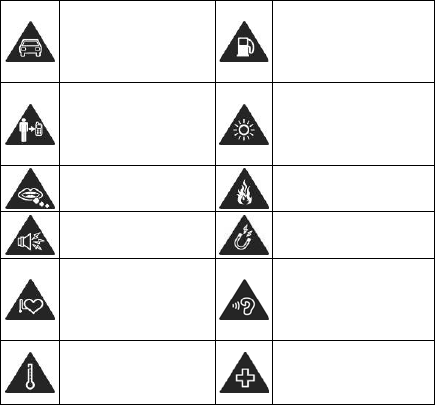
8
For Your Safety
General Safety
Don’t make or receive
handheld calls while
driving. And never text
while driving.
Don’t use at petrol
stations.
Keep your phone at
least 10 mm away from
your body while making
calls.
Your phone may produce
a bright or flashing light.
Small parts may cause
a choking.
Don’t dispose of your
phone in fire.
Your phone can
produce a loud sound.
Avoid contacting with
anything magnetic.
Keep away from
pacemakers and other
electronic medical
devices.
To prevent possible
hearing damage, do not
listen at high volume
levels for long periods.
Avoid extreme
temperatures.
Switch off when asked to
in hospitals and medical
facilities.
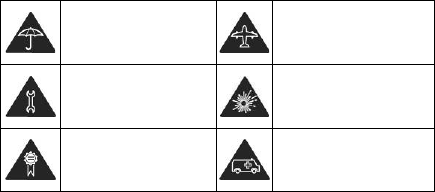
9
Avoid contacting with
liquids. Keep your
phone dry.
Switch off when told to in
aircrafts and airports.
Don’t take your phone
apart.
Switch off when near
explosive materials or
liquids.
Only use approved
accessories.
Don’t rely on your phone
for emergency
communications.
Distraction
Driving
Full attention must be given to driving at all times in order to
reduce the risk of an accident. Using a phone while driving
(even with a hands free kit) can cause distraction and lead to
an accident. You must comply with local laws and
regulations restricting the use of wireless devices while
driving.
Operating Machinery
Full attention must be given to operating the machinery in
order to reduce the risk of an accident.
10
Product Handling
General Statement on Handling and Use
You alone are responsible for how you use your phone and
any consequences of its use.
You must always switch off your phone wherever the use of a
phone is prohibited. Use of your phone is subject to safety
measures designed to protect users and their environment.
Always treat your phone and its accessories with care
and keep it in a clean and dust-free place.
Do not expose your phone or its accessories to open
flames or lit tobacco products.
Do not expose your phone or its accessories to liquid,
moisture or high humidity.
Do not drop, throw or try to bend your phone or its
accessories.
Do not use harsh chemicals, cleaning solvents, or
aerosols to clean the device or its accessories.
Do not paint your phone or its accessories.
Do not attempt to disassemble your phone or its
accessories, only authorized personnel can do so.
Do not expose your phone or its accessories to extreme
temperatures, minimum - [20] and maximum + [60]
degrees Celsius.
11
The phone's normal operating temperature is 0℃ ~
45℃ .In order to ensure the normal phone functions, do
not use this phone outside the temperature range.
Please check local regulations for disposal of electronic
products.
Do not carry your phone in your back pocket as it could
break when you sit down.
Use careful with the earphone maybe possible excessive
sound pressure from earphones and headphones can
cause hearing loss.
Small Children
Do not leave your phone and its accessories within the reach
of small children or allow them to play with it.
They could hurt themselves or others, or could accidentally
damage the phone.
Your phone contains small parts with sharp edges that may
cause an injury or may become detached and create a
choking hazard.
Demagnetization
To avoid the risk of demagnetization, do not allow electronic
devices or magnetic media close to your phone for a long
time.
12
Electrostatic Discharge (ESD)
Do not touch the nano-SIM card’s metal connectors.
Antenna
Do not touch the antenna unnecessarily.
Normal Use Position
When placing or receiving a phone call, hold your phone to
your ear, with the bottom towards your mouth.
Air Bags
Do not place a phone in the area over an air bag or in the air
bag deployment area.
Store the phone safely before driving your vehicle.
Seizures/ Blackouts
The phone can produce a bright or flashing light.
Repetitive Motion Injuries
To minimize the risk of RSI when texting or playing games
with your phone:
Do not grip the phone too tightly.
Press the buttons lightly.
Use the special features which are designed to minimize
the times of pressing buttons, such as Message
13
Templates and Predictive Text.
Take lots of breaks to stretch and relax.
Emergency Calls
This phone, like any wireless phone, operates using radio
signals, which cannot guarantee connection in all conditions.
Therefore, you must never rely solely on any wireless phone
for emergency communications.
Loud Noise
This phone is capable of producing loud noises, which may
damage your hearing. Turn down the volume before using
headphones, Bluetooth stereo headsets or other audio
devices.
Phone Heating
Your phone may become warm during charging and during
normal use.
Electrical Safety
Accessories
Use only approved accessories.
Do not connect with incompatible products or accessories.
Take care not to touch or allow metal objects, such as
coins or key rings, to contact or short-circuit in the battery
14
terminals.
Connection to a Car
Seek professional advice when connecting a phone interface
to the vehicle electrical system.
Faulty and Damaged Products
Do not attempt to disassemble the phone or its accessory.
Only qualified personnel can service or repair the phone or
its accessory.
If your phone or its accessory has been submerged in water,
punctured, or subjected to a severe fall, do not use it until
you have taken it to be checked at an authorized service
centre.
Interference
General Statement on Interface
Care must be taken when using the phone in close
proximity to personal medical devices, such as pacemakers
and hearing aids.
Pacemakers
Pacemaker manufacturers recommend that a minimum
separation of 15 cm be maintained between a mobile phone
and a pacemaker to avoid potential interference with the
15
pacemaker. To achieve this, use the phone on the opposite
ear to your pacemaker and do not carry it in a breast pocket.
Hearing Aids
People with hearing aids or other cochlear implants may
experience interfering noises when using wireless devices or
when one is nearby.
The level of interference will depend on the type of hearing
device and the distance from the interference source,
increasing the separation between them may reduce the
interference. You may also consult your hearing aid
manufacturer to discuss alternatives.
Medical Devices
Please consult your doctor and the device manufacturer
to determine if operation of your phone may interfere with
the operation of your medical device.
Hospitals
Switch off your wireless device when requested to do so in
hospitals, clinics or health care facilities. These requests are
designed to prevent possible interference with sensitive
medical equipment.
Aircraft
Switch off your wireless device whenever you are instructed
to do so by airport or airline staff.
16
Consult the airline staff about the use of wireless devices on
board the aircraft. If your device offers a ‘flight mode’, this
must be enabled prior to boarding an aircraft.
Interference in Cars
Please note that because of possible interference to
electronic equipment, some vehicle manufacturers forbid
the use of mobile phones in their vehicles unless a
hands-free kit with an external antenna is included in the
installation.
Explosive Environments
Petrol Stations and Explosive Atmospheres
In locations with potentially explosive atmospheres, obey all
posted signs to turn off wireless devices such as your phone
or other radio equipment.
Areas with potentially explosive atmospheres include fuelling
areas, below decks on boats, fuel or chemical transfer or
storage facilities, areas where the air contains chemicals or
particles, such as grain, dust, or metal powders.
Blasting Caps and Areas
Power off your mobile phone or wireless device when in a
blasting area or in areas posted power off “two-way radios”
or “electronic devices” to avoid interfering with blasting
operations.
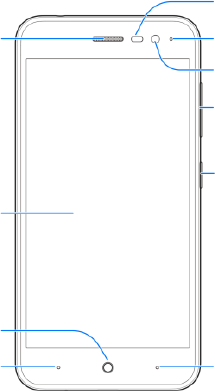
17
Getting Started
Overview
Front camera
Volume ke
y
Earpiece
Proximity & light
sensor
Back ke
y
Recent apps key
Indicator light
Touch screen
Power key
Home ke
y
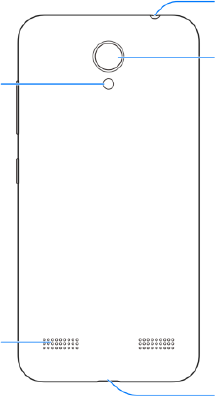
18
Flash
Headset
j
ac
k
Back
camera
Speaker
Charging/
micro-USB jack

19
Keys Explained
Key Function
Power Key Press and hold to turn on or off airplane
mode, restart, select phone modes, or
power off.
Press to turn off or on the screen display.
Home Key Touch to return to the home screen from
any application or screen.
Touch and hold to use Google Search.
Back Key Touch to go to the previous screen.
Recent apps
Key Touch to see recently used apps.
Volume Key Press or hold either end of the key to turn the
volume up or down.
NOTE:
The positions of the Recent apps key and the Back key are
interchangeable through Settings > Featured > Navigation
keys.

20
Starting up
Installing the nano-SIM Card and the microSDXC™ Card
The nano-SIM card can be installed or removed while the
phone is turned on.Power off your phone before removing or
replacing the battery.
The microSDXC card (optional, not included) can be installed
or removed while the phone is turned on. You need to
unmount the microSDXC card before removing it.
WARNING!
To avoid damage to the phone, do not use any other kind of
SIM cards, or any non-standard nano-SIM card cut from a
SIM card. You can get a standard nano-SIM card from your
service provider.
1. Place your finger in the slot at the bottom of the back
cover to lift and remove the cover.
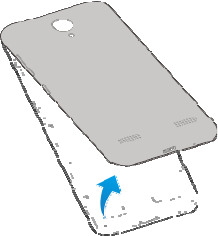
21
2. Hold the nano-SIM card with their cut corner oriented as
shown and slip it into the card holder.
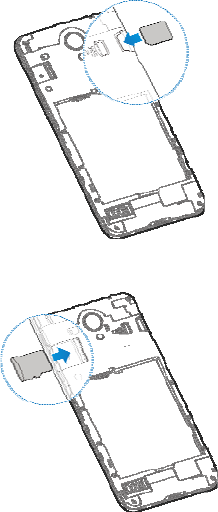
22
3. Hold your microSDXC card with the metal contacts facing
down and slide it into the microSDXC card slot.
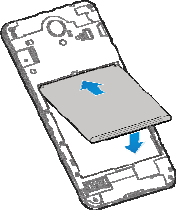
23
4. Insert the battery by aligning the golden contacts on the
battery and those in the battery compartment. Gently
push down on the battery until it clicks into place.
5. Replace the back cover.
Align the back cover with the bottom of the phone.①
Press the cover back into place②.
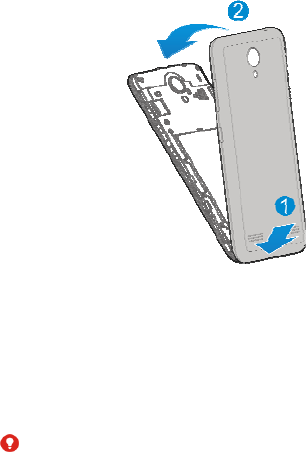
24
Charging the Battery
Your phone’s battery should have enough power for the
phone to turn on, find a signal, and make a few calls. You
should fully charge the battery as soon as possible.
If the battery is low, there will be a pop-up message on the
screen. As you charge your phone, the lock screen will show
you the exact battery level on the status bar.
WARNING!
Use only ZTE-approved chargers and cables. The use of
unapproved accessories could damage your phone or cause
the battery to explode.
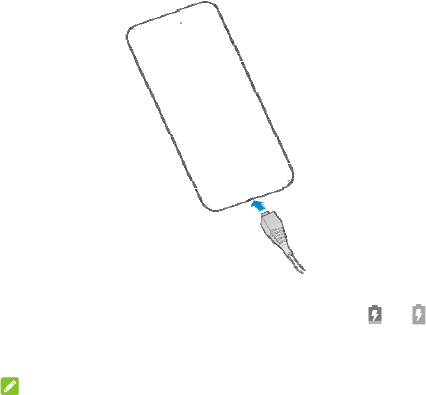
25
1. Connect the adapter to the charging jack. Ensure that the
adapter is inserted with the correct orientation. Do not
force the connector into the charging jack.
2. Connect the charger to a standard AC power outlet. If the
phone is on, you’ll see a charging icon, such as or ,
appear on the status bar.
3. Disconnect the charger when the battery is fully charged.
NOTE:
If the battery is extremely low, you may be unable to power
on the phone even when it is being charged. In this case, try
again after charging the phone for at least 20 minutes.

26
Contact the customer service if you still cannot power on the
phone after prolonged charging.
Powering On/Off
Press and hold the Power key to turn on your phone.
To switch it off, hold Power key to open the options menu
and touch Shut down.
Setting Up for the First Time
When you first power on your phone after you purchase it or
reset it to factory settings, you need to do some settings
before using it.
Touch the language field to select the language you want to
use and then touch GET SATRTED. Then follow the prompts
to set up Wi-Fi, Google services, add fingerprint and other
options.
Waking Up Your Phone
1. Press the Power key to turn the screen on.
2. Drag towards .
- or -
You can drag towards any direction to access the
application shortcuts.
NOTES:
27
You can pull out the starts on the left for a quick view or
action when the screen is turned on.
If you have set an unlock pattern, PIN or complex
password for your phone, you’ll need to draw the pattern
or enter the PIN/password to unlock your screen.
Getting Around Your Phone
Touch Control
You can use finger gestures to control your phone. The
controls on your touch-screen change dynamically
depending on the tasks you’re performing.
Touch the buttons, icons, or applications to select items
or to open applications.
Flick the screen to scroll up, down, left or right.
Hold and drag to move particular items across the screen.
Double-tap the screen to zoom in/out an image. Pinch on
with two fingers to zoom in/out a web page.
Home Screen
The home screen is the starting point for your phone’s
applications, functions, and menus. You can customize your
home screen by adding folders, widgets, and more.
Extended Home Screen
Your home screen is extendable, providing more space for

28
shortcuts, folders, widgets, and more. Simply swipe left or
right on the screen to see the extended panels.
Choosing Your Wallpaper
You can set the wallpaper for the home screen and lock
screen.
1. Touch the Home key and slide on the screen to select
Settings > Themes & wallpapers > Wallpapers.
2. Touch Home screen wallpaper or Lock screen
wallpaper and select a built-in static wallpaper, or touch
Gallery to select a picture, crop it, and use it as the
wallpaper.
NOTE:
Other way to set the home screen wallpaper and the lock
screen wallpaper:
Touch and hold an empty area of the home screen and
select Customize launcher > Wallpaper tab. Then select a
built-in image or an image from your gallery. You can also
touch Camera to take a photo as the wallpaper.
Removing Items from Your Home Screen
1. Touch and hold the item you want to delete.
2. Drag it to to delete it.
3. If the item is an application, touch OK to uninstall it.
NOTE:
Some preinstalled apps cannot be uninstalled.
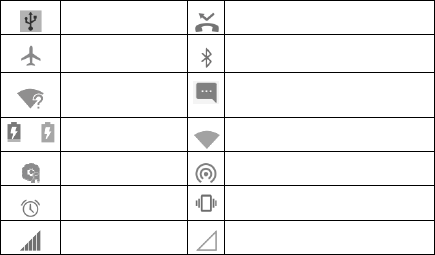
29
Status and Notification Icons
Your phone will tell you exactly what’s going on by showing
you simple icons. Here’s what they mean.
USB tethering on Missed call
Airplane mode Bluetooth icon
New Wi-Fi network
detected New message
/ Battery charge Connected to a Wi-Fi® network
Song playing Portable Wi-Fi hotspot is on
Alarm set Vibration on
Signal strength No signal
Open/Close the Notification Panel
Notifications report the arrival of new messages, calendar
events, and alarms, as well as ongoing events, such as when
you've configured your phone as a Wi-Fi hotspot. You can
open the notification panel to view the details of notifications.
To open the notification panel, swipe your finger down
from the top of the screen.
To close the notification panel, swipe your finger up on
the screen or touch the Back key.

30
Phone Calls
Making Calls
You can place calls from the Phone app, the People app, or
other apps or widgets that display contact information.
Wherever you see a phone number, you can usually touch it
to dial.
Calling from the Phone
1. Touch the Home key > .
2. Enter the phone number with the dialpad. Touch to
delete incorrect digits.
3. Touch below the keypad to dial.
NOTE:
To make an international call, touch and hold the 0 key to
enter the plus (+) symbol. Next, enter the country code,
followed by the city/area code and then the phone number.
Calling from Your Contacts
1. Touch the Home key and slide on the screen to select
Contacts.
2. Touch next to a contact to place the call.

31
Calling from Your Call History
1. Touch the Home key > > Phone.
2. Touch a listing to call back.
NOTE:
You can touch All calls, Incoming calls, Outgoing calls,
Missed calls, or Rejected calls to filter the records by
call type.
Calling from a Text Message
If a text message contains a phone number that you want to
call, you can make the call while viewing the text message.
1. Touch the Home key > .
2. Touch the conversation and then find the message that
contains the phone number you need.
3. Touch the number and touch Call.
Receiving Calls
Answering a Call
When you receive a phone call, slide down to answer
the call.

32
Rejecting a Call
When you receive a phone call, slide up to reject the call.
Muting a Call
During a call, you can mute your microphone so that the
person you are speaking to cannot hear you, but you can still
hear them.
Touch to turn your microphone off. To turn your
microphone back on, touch again.
Turning the Speakerphone On/Off
Touch during a call to turn the speakerphone on. Touch
again to turn off the speakerphone.
Ending a Call
Touch to finish a call.
Call settings
Touch the Home key > > > Call settings.
Speed Dials: Touch and hold the 1 ~ 9 keys from the
dialer to call the corresponding speed dial number.
Auto-Answer: Configure your phone to answer calls
automatically when you are not in a call.

33
Voicemail: Touch to configure voicemail settings.
Call Barring Settings: Call barring feature allows you to
forbid certain types of calls from your phone.
Fixed Dialing Numbers: Fixed Dialing Numbers (FDN)
allows you to restrict outgoing calls to a limited set of
phone numbers.
Call forwarding: Call forwarding feature allows you to
forward your incoming calls to another phone number.
Additional settings: Touch Caller ID to choose whether
your number is displayed when someone receives your
outgoing call. Or check Call waiting to get notified of
incoming calls during a call.
Set operations for a call not answered: Enable
operations for a call not answered to send a message or
call another number after the call ends.
Block calls that ring just once: Configure your phone to
block calls that ring just once.
Contacts
You can add contacts on your phone and synchronize them with
the contacts in your Google account or other accounts that
support contact syncing.
To see your contacts, touch the Home key and slide on the
screen to select .

34
Creating a Contact
1. Press the Home key and slide on the screen to select
.
2. Touch to add a new contact.
3. Touch the account field near the top of the screen to
choose where to save the contact. You can save the
contact on the phone, a nano-SIM card, or a web account
you have added on the phone.
4. Enter the contact name, phone numbers, email
addresses, and other information.
5. Touch Save.
Searching for a Contact
1. Press the Home key and slide on the screen to select
.
2. Enter the contact name or any information the contact has
to search for it at the top.
The contacts matched will be listed.

35
Messaging
You can use Messaging to exchange text messages (SMS)
and multimedia messages (MMS).
Opening the Messaging Screen
Touch the Home key > .
The Messaging screen opens, where you can create a new
message, search for messages, delete messages, or open
an ongoing message thread.
Touch to write a new text or multimedia message.
Touch to search for a message using keywords.
Touch to select message threads for deletion.
Touch an existing message thread to open the
conversation you’ve had with a certain number.
Sending a Message
1. On the Messages screen, touch at the bottom.
2. Add recipients by one of the following ways.
Touch the To field and manually enter the recipient’s
number or the contact name. If the phone presents a
few suggestions, touch the one you want to add.

36
Select recipients from your contacts or call log by
touching .
3. Touch the Enter a message field and enter the message
text.
4. If you want to send a multimedia message, touch to
add a subject or attach a file to the message.
5. Touch .
NOTE:
You can also include email addresses as recipients for a
multimedia message.
NOTE:
Do not add a message subject or any attachment if you
want to send a text message. Otherwise you may be
charged for a multimedia message.
Message Settings
Touch > Settings in the Messages screen to change the
messaging settings.

37
Connecting to Networks and
Devices
Set Access Point Names
To connect to the Internet you can use the default Access
Point Names (APN). And if you want to add a new APN,
please contact the service provider to get the necessary
information.
1. Touch the Home key and slide on the screen to select
Settings > Mobile networks.
2. Touch Access Point Names > .
3. Touch each item to enter the information you get from
your service provider.
4. Touch > Save to complete.
NOTE:
To set the APN to default settings, touch > Reset to
default.
Turn Wi-Fi On and Connect to a Wi-Fi
Network
1. Touch the Home key and slide on the screen to select
Settings > Wi-Fi.

38
2. Slide the switch next to Wi-Fi to turn on Wi-Fi.
3. Touch a network name to connect to it.
4. If the network is secured, enter the password and touch
Connect.
NOTE:
Your phone automatically connects to previously used Wi-Fi
networks when they are in range.
Bluetooth
Bluetooth® is a short-range wireless communication
technology. Phones or other devices with Bluetooth
capabilities can exchange information wirelessly within a
distance of about 10 meters (32.8 feet). The Bluetooth
devices must be paired before the communication is
performed.
1. Touch the Home key and slide on the screen to select
Settings > Bluetooth.
2. Slide the switch next to Bluetooth to turn on or off
Bluetooth.
When Bluetooth is on, the icon appears in the status
bar.

39
Tethering & portable hotspot
You can share your phone’s data capabilities through
tethering or by activating the mobile hotspot feature to create
a portable Wi-Fi hotspot.
Share Your Mobile Data Connection via USB
You cannot transfer files between your phone and your
computer via USB while the phone is USB tethered.
1. Connect your phone to your computer with a USB cable.
2. Touch the Home key slide on the screen to select
Settings > More.
3. Switch on USB tethering. A new network connection will
be created on your computer.
NOTE:
To stop sharing your data connection, switch off USB
tethering or disconnect the USB cable.
Share Your Mobile Data Connection via Bluetooth
1. Pair your phone with your computer via Bluetooth.
2. Configure your computer to obtain its network connection
via Bluetooth. For more information, please see your
computer's documents.
3. Touch the Home key slide on the screen to select
Settings > More.
4. Switch on Bluetooth tethering. Your computer is now

40
sharing your phone's data connection.
NOTE:
To stop sharing your data connection, switch off Bluetooth
tethering.
Share Your Mobile Data Connection as a Wi-Fi Hotspot
When the portable Wi-Fi hotspot feature is enabled, you
cannot use your phone’s Wi-Fi capability to access the
Internet. You still remain connected to the Internet via your
mobile data network.
1. Touch the Home key slide on the screen to select
Settings > Wi-Fi hotspot.
2. Switch on Wi-Fi hotspot.
After a moment, the phone starts broadcasting its Wi-Fi
network name (SSID).
3. On another device, locate your phone via Wi-Fi and
connect with it to start using the phone’s mobile data.
NOTE:
To stop sharing your data connection, switch off Wi-Fi
hotspot.

41
Browser
Use Browser to view web pages and search for information.
Opening the Browser
Touch the Home key > to launch the web browser.
You can also open the browser by touching a web link - for
example, in an email or a text message.
1. Open the Browser app.
2. Touch the address box.
3. Enter the address (URL) of a web page or enter terms
you want to search for.
4. Touch a URL or search suggestion or touch on the
keyboard to open the web page or search results.
Using Multiple Browser Tabs
You can open several web pages at the same time (one page
in each tab) and switch between them freely.
To open a new browser tab:
Touch > New window. A new browser tab opens.
To switch between tabs:
1. Touch . Titles of opened tabs appear as a list.
2. Touch the title you want to open.

42
NOTE:
Swipe a title horizontally or touch its to close the tab.
Downloading Files
1. Touch and hold an image or a link to a file or to another
web page.
2. In the menu that opens, touch Save image or Save link.
The downloaded files are saved to your phone. You can view
or open them in the Downloads app.
Changing Browser Settings
You can configure a number of settings to customize the way
you browse the web, including several that you can use to
control your privacy.
To open the browser settings screen, touch > Settings.
Using Multimedia Apps
Taking Pictures with Your Camera
1. Touch the Home key and slide on the screen to touch
.
2. Aim the camera at the subject and make any necessary
adjustment.
NOTE:
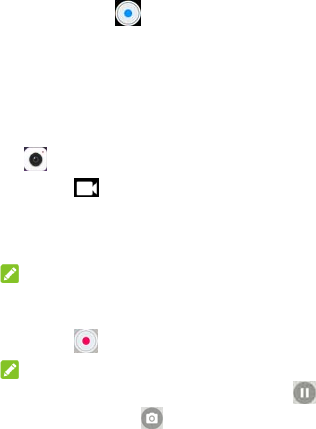
43
You can spread or pinch on the screen to zoom in or out
before taking pictures.
3. Touch the area where you want the camera to focus, or
leave the camera to autofocus on the center of the image.
4. Lightly touch . The Volume key can also be used to take
a photo
Recording Videos with Your
Camcorder
1. Touch the Home key and slide on the screen to touch
.
2. Touch .
3. Aim the camera at the subject. You can touch any area on
the screen that you want the camcorder to focus on
before and during recording.
NOTE:
You can spread or pinch on the screen to zoom in or out
before and during recording.
4. Touch to start recording a video.
NOTE:
While the recording is in progress, touch to pause the
recording, or touch to save the frame as a separate

44
photo.
5. Touch to stop recording.
Listening to Your FM Radio
With the FM Radio, you can search for radio channels, listen
to them, and collect them to your phone. Note that the quality
of the radio broadcast depends on the coverage of the radio
station in your area. The wired headset works as an antenna,
so always connect the headset when using the radio.
1. Plug your headset into your phone.
2. Touch the Home key and slide on the screen to select FM
Radio.
Playing Your Music
Music supports a wide variety of audio formats, so it can play
music you purchase from online stores, music you copy from
your CD collection, and so on.
1. Touch the Home key and slide on the screen to touch
Music > All songs to see the music library.
2. Touch a song in any list.
Opening Your Gallery
Touch the Home key and slide on the screen to select
Gallery to view albums of your pictures and videos.

45
Making Voice Memos
Recorder enables you to record voice memos and listen to
them whenever you like.
1. Press the Home key and slide on the screen to select
Recorder.
2. Touch to select audio format.
3. Touch to start recording. During recording, you can
do the following:
Touch / to pause or continue the recording.
Touch to add time tags to the recording.
4. Touch Save to stop recording.
5. Edit the file name and touch OK to save the recording.
If you don’t want to save the memo after recording it, touch
Cancel to delete it.
Using Your Google Applications
Signing in to your Google Account lets you synchronize
Gmail, Calendar, and Contacts between your phone and the
web. And if you don’t have an account, you can easily create
one.

46
Gmail
Gmail is a web-based email service that’s configured when
you sign in to your Google account. Depending on your
synchronization settings, the Gmail on your phone can be
automatically synchronized with your Gmail account on the
web. This is how to enter Gmail:
To open Gmail by touching the Home key > Google> Gmail.
Google Play™ Store
Touch the Home key > . You can buy or rent music,
books, movies, apps, and download them to your phone.
NOTE:
The content you can access in Google Play Store depends
on your region and your service provider.
Other Applications
Clock
Touch the Home key and slide on the screen to select Clock.
The Clock app allows you to check local time in places
around the world, set alarms, and use timers.

47
Mi-Moment
Touch the Home key and slide on the screen to select
Mi-Moment to save and view your text notes.
Touch to create a new note. Then enter your text and
touch SAVE.
Touch a note to view its entire contents. Touch or
to edit, delete, share, export, lock, move it to folder, or
view its details.
FileManager
Quickly access all of your images, videos, audio clips, and
other types of files on your phone storage.
Touch the Home key and slide on the screen to select
FileManager. You can touch a file category to find the file
you need, or touch Phone, SD Card, or External devices to
browse folders and files on the phone storage, the
microSDXC card, or the connected OTG device.
Settings
The Settings app contains most of the tools for customizing
and configuring your phone.
48
Wi-Fi
Touch the Home key and slide on the screen to select
Settings > Wi-Fi. You can turn Wi-Fi on or off and configure
your Wi-Fi connections.
Bluetooth
Touch the Home key and slide on the screen to select
Settings > Bluetooth. You can turn Bluetooth on or off and
configure your Bluetooth connections.
Wi-Fi hotspot
Touch the Home key and slide on the screen to select
Settings > Wi-Fi hotspot to share your phone’s mobile data
connection with PCs or other devices via Wi-Fi.
Airplane Mode
Touch the Home key and slide on the screen to select
Settings > More, and then slide the switch beside Airplane
mode to turn airplane mode on or off. All the phone’s radios
that transmit voice or data are turned off when airplane mode
is on.

49
Enable 4G
Touch the Home key and slide on the screen to select
Setting > More, and then slide the switch beside Enable 4G
to connect to 4G LTE network.
Data Usage
Touch the Home key and slide on the screen to select
Settings > More > Data usage to manage mobile data use.
Touch the Cellular data switch to turn on or off mobile data.
Touch Cellular data usage to check how much data has
been used during the time cycle you set, set mobile data limit
and warning, see what apps have been using mobile data, or
restrict background data for individual apps.
NOTE:
The data usage is measured by your phone, and your
carrier’s data usage accounting may differ.
VPN
Touch the Home key and slide on the screen to select
Settings > More > VPN to set up and connect to virtual
private networks.
50
USB Tethering
Touch the Home key and slide on the screen to select
Settings > More > USB Tethering to share your phone’s
mobile data connection with PCs or other devices via USB.
Bluetooth Tethering
Touch the Home key and slide on the screen to select
Settings > More > Bluetooth Tethering to share your
phone’s mobile data connection with PCs or other devices
via Bluetooth.
Hotspot & Tethering Settings
Touch the Home key and slide on the screen to select
Settings > More > Hotspot & tethering settings to
configure hotspot and tethering settings.
ZTE Locker
Touch the Home key and slide on the screen to select
Settings > ZTE Locker. You can turn on or off ZTE locker
and configure the options for lock screen settings.
Themes & Wallpapers
Touch the Home key and slide on the screen to select
Settings > Themes & wallpapers. You can select a different
51
theme for the phone display, or change the home/lock screen
wallpaper.
Display
Touch the Home key and slide on the screen to select
Settings > Display to configure the display options.
Sound
Touch the Home key and slide on the screen to select
Settings > Sound. You can adjust different types of volume,
toggle sound, vibration and mute, set up ringtone and
notification sound, or select touch sounds.
Notifications
Touch the Home key and slide on the screen to select
Settings > Notifications to control the display of
notifications.
Navigation keys
Touch the Home key and slide on the screen to select
Settings > Featured > Navigation keys. You can exchange
the location of the Recent apps key and the Back key.

52
Apps
Touch the Home key and slide on the screen to select
Settings > Apps to see apps installed on your phone and
manage them.
Default Apps
Touch the Home key and slide on the screen to select
Settings > Default apps to set the default application for
certain operation. For example, you can set Email or Gmail
as the default email app. Touch > Restore defaults to
return to the default settings.
Power Manager
Touch the Home key and slide on the screen to select
Settings > Power manager to view the battery level, check
what has been using the battery, and enable different battery
saving modes.
Security
Touch the Home key and slide on the screen to select
Settings > Security to configure options that help keep your
phone and data safe.
53
Accounts
Touch the Home key and slide on the screen to select
Settings > Accounts to manage your web accounts and
synchronization. Touch Add account to sign in to or create
accounts on your phone.
Touch an account type to see that type of accounts you have
added and adjust the accounts settings.
Languages & Input
Touch the Home key and slide on the screen to select
Settings > Advanced settings > Languages & input to
configure options related to system language, input methods,
speech input and output as well as mouse/trackpad input.
Date & Time
Touch the Home key and slide on the screen to select
Settings > Advanced settings > Date & time to set date,
time, time zone, time format and more.
Backup and Reset
Press the Home key, slide on the screen and touch
Settings > Advanced settings > Backup & reset to
manage data backup and restoration options, and to reset
the network setting or the phone to factory status.
54
Memory
Touch the Home key and slide on the screen to select
Settings > Advanced settings > Memory to monitor the
average memory use and performance of your phone. You
can also check which apps use the most memory.
Storage
Touch the Home key and slide on the screen to select
Settings > Advanced settings > Storage to view the
memory information of the internal phone storage and the
microSDXC card.
Touch Phone memory to get a detailed breakdown of space
usage by type. Touch a data type to see more information or
delete the files you do not need.
Connect to PC
Touch the Home key and slide on the screen to select
Settings > Advanced settings > Connect to PC to select
your USB connection type between your phone and PC.
55
Scheduled Power On/Off
Touch the Home key and slide on the screen to select
Settings > Advanced settings > Scheduled power on/off
to set the day and time when the phone automatically powers
on or off. You can also touch the switches on the right to turn
the features on or off.
Location
Touch the Home key and slide on the screen to select
Settings > Advanced settings > Location to manage
location services, which help your phone and apps determine
your location. To use location-related applications, such as
finding your location on Google Maps, you must have
location services turned on on your phone.
1. Slide the switch at the top to turn location services on or
off.
2. When location is enabled, touch Mode to select location
sources you want to use.
In the Location menu, touch Google Location History to
configure Google location options.
56
Google
Touch the Home key and slide on the screen to select
Settings > Advanced settings > Google to easily manage
settings for Google apps and features. You can set the
options for Google account and services.
Accessibility
Touch the Home key and slide on the screen to select
Settings > Advanced settings > Accessibility to configure
accessibility plug-ins and services on your phone, such as
using Color inversion or High contrast text for users with
sight problems.
Printing
Touch the Home key and slide on the screen to select
Settings > Advanced settings > Printing to manage
Google Cloud Print service or other printer plug-ins installed
from the Google Play Store or your printer manufacturer.
System Update
Touch the Home key and slide on the screen to select
Settings > System Update to check, download and install
system updates.
57
About Phone
Touch the Home key and slide on the screen to select
Settings > About phone to view important phone
information and legal information. You can also touch My
phone name to give your phone a name for easy
identification when others want to connect to your phone via
Bluetooth or Wi-Fi hotspot.
FCC RF Exposure Information (SAR)
This phone is designed and manufactured not to exceed the
emission limits for exposure to radio frequency (RF) energy
set by the Federal Communications Commission of the
United States.
During SAR testing, this device was set to transmit at its
highest certified power level in all tested frequency bands,
and placed in positions that simulate RF exposure in usage
against the head with no separation, and near the body with
the separation of 10 mm. Although the SAR is determined at
the highest certified power level, the actual SAR level of the
device while operating can be well below the maximum value.
This is because the phone is designed to operate at multiple
power levels so as to use only the power required to reach
58
the network. In general, the closer you are to a wireless base
station antenna, the lower the power output.
The exposure standard for wireless devices employing a unit
of measurement is known as the Specific Absorption Rate, or
SAR.
The SAR limit set by the FCC is 1.6W/kg. This device is
complied with SAR for general population /uncontrolled
exposure limits in ANSI/IEEE C95.1-1992 and had been
tested in accordance with the measurement methods and
procedures specified in IEEE1528.
The FCC has granted an Equipment Authorization for this
model phone with all reported SAR levels evaluated as in
compliance with the FCC RF exposure guidelines. SAR
information on this model phone is on file with the FCC and
can be found under the Display Grant section of
www.fcc.gov/oet/ea/fccid after searching on
FCC ID:SRQ-BLADEA520
For this device, the highest reported SAR value for usage
against the head is 0.65 W/kg, for usage near the body is
1.18 W/kg.
59
While there may be differences between the SAR levels of
various phones and at various positions, they all meet the
government requirements.
SAR compliance for body-worn operation is based on a
separation distance of 10 mm between the unit and the
human body. Carry this device at least 10 mm away from
your body to ensure RF exposure level compliant or lower to
the reported level. To support bodyworn operation, choose
the belt clips or holsters, which do not contain metallic
components, to maintain a separation of 10 mm between this
device and your body.
RF exposure compliance with any body-worn accessory,
which contains metal, was not tested and certified, and use
such body-worn accessory should be avoided.
FCC Regulations
This mobile phone complies with part 15 of the FCC Rules.
Operation is subject to the following two conditions: (1) This
device may not cause harmful interference, and (2) this
device must accept any interference received, including
interference that may cause undesired operation.
This mobile phone has been tested and found to comply with
60
the limits for a Class B digital device, pursuant to Part 15 of
the FCC Rules.
These limits are designed to provide reasonable protection
against harmful interference in a residential installation. This
equipment generates, uses and can radiate radio frequency
energy and, if not installed and used in accordance with the
instructions, may cause harmful interference to radio
communications.
However, there is no guarantee that interference will not
occur in a particular installation. If this equipment does cause
harmful interference to radio or television reception, which
can be determined by turning the equipment off and on, the
user is encouraged to try to correct the interference by one or
more of the following measures:
• Reorient or relocate the receiving antenna.
• Increase the separation between the equipment and
receiver.
• Connect the equipment into an outlet on a circuit different
from that to which the receiver is connected.
• Consult the dealer or an experienced radio/TV technician
for help.
61
CAUTION: Changes or modifications not expressly approved by
the party responsible for compliance could void the user’s
authority to operate the equipment.
The antenna(s) used for this transmitter must not be
co-located or operating in conjunction with any other antenna
or transmitter.